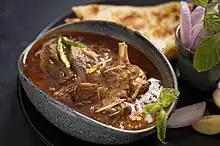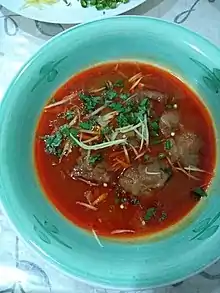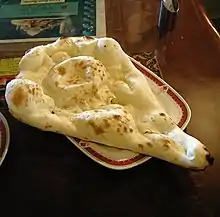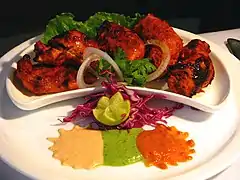 Mutton Nihari | |
| Course | Breakfast, lunch, dinner |
|---|---|
| Place of origin | Indian subcontinent |
| Region or state | Lucknow, Awadh |
| Associated cuisine | Indian, Pakistani, Bangladeshi[1] |
| Invented | 18th century |
| Serving temperature | Hot |
| Main ingredients | Shank cut of beef (mainly in Pakistan), lamb and mutton, goat meat, or camel meat, as well as chicken and bone marrow |
| Other information | Served with naan or rice |
Nihari (Hindi: निहारी; Bengali: নিহারী; Urdu: نہاری) is a stew originating in Lucknow, the capital of 18th-century Awadh under the Mughal Empire in the Indian subcontinent. It consists of slow-cooked meat, mainly a shank cut of beef, lamb and mutton, or goat meat, as well as chicken and bone marrow. It is flavoured with long pepper (pippali), a relative of black pepper. In Pakistan and Bangladesh, nihari is often served and consumed with naan.
Etymology
The name nihari originates from Arabic nahâr (نهار), meaning "morning";[2][3][4] it was originally eaten by nawabs in the Mughal Empire as a breakfast course following Fajr prayer.[2][4]
History
According to many sources, nihari originated in the royal kitchens of Lucknow, Awadh (modern-day Uttar Pradesh, India), in the late 18th century, during the last throes of the Mughal Empire.[3] It was originally meant to be consumed as a heavy, high-energy breakfast dish on an empty stomach by working-class citizens, particularly in colder climates and seasons. However, the dish later gained a significant amount of popularity and eventually became a staple of the royal cuisine of Mughal-era nawabs.[5][6]
Nihari developed with the overall cuisine of the Muslims of the Indian subcontinent. It remains a popular delicacy, especially in parts of Old Delhi & Lucknow. After 1947 through migration gained popularity in Lahore, Karachi, Peshawar, Dhaka, and Chittagong. The dish is known for its spiciness, taste, texture, and gravy.[7][4]
Popularity
Nihari is a traditional dish among the Indian Muslim communities of Lucknow, Delhi, and Bhopal. Following the partition of India in 1947, many Urdu-speaking Muslims from northern India migrated to Karachi in West Pakistan and Dhaka in East Pakistan, and established a number of restaurants serving the dish. In Karachi, nihari became a large-scale success[8] and soon spread in prominence and availability across Pakistan.

In some restaurants, a few kilograms from each day's leftover nihari is added to the next day's pot; this reused portion of the dish is known as taar and is believed to provide a unique flavour. Some nihari outlets in Old Delhi claim to have kept an unbroken cycle of taar going for more than a century.[9]
Medicinal remedies
Nihari is also used as a home remedy for fever, rhinorrhea, and the common cold.[10]
See also
References
- ↑ "20 delicious reasons to visit Pakistan". 15 October 2019.
- 1 2 Sengupta, Sushmita (3 January 2018). "Nihari: History Of The Meaty and Buttery Breakfast Staple of The Mughals". NDTV Food. Retrieved 3 January 2018.
- 1 2 Chakravorty, Deblina (12 April 2012). "Nihari, a gift from Nawabs". The Times of India. Retrieved 5 March 2016.
- 1 2 3 "Nihari- historical recipe". Homtainment. 23 December 2020. Retrieved 23 December 2020.
- ↑ "In celebration of winter's perfect dish, the mutton nihari!". Hindustan Times. 4 November 2017. Retrieved 30 January 2021.
- ↑ "Do you know what is Nalli Nihari? History of Nihari and recipe of Nalli Nihari". infusecooking.com. 29 June 2021. Retrieved 28 June 2022.
- ↑ "Nahari". Retrieved 5 March 2016.
- ↑ "Nihari a la Mexican style". The Hindu Business Line. Retrieved 5 March 2016.
- ↑ Sengupta, Sushmita (20 January 2022). "Nihari's 'Taar' to Dahi's 'Jamun': The Desi Art Of Using Remains Of Previous Batch To Flavour Next". Slurrp.com. Retrieved 22 December 2023.
- ↑ "What is Nihari?". Archived from the original on 19 December 2014. Retrieved 28 November 2014.


